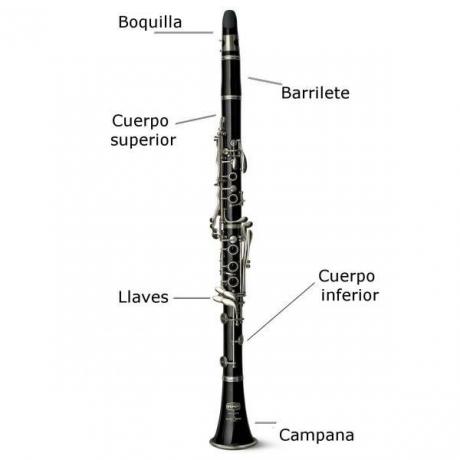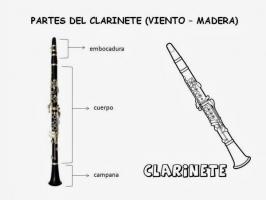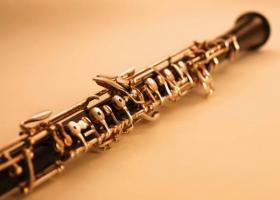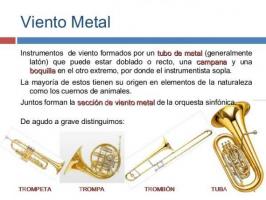All PARTS of the CLARINET

Image: Music with Veronica
A tool is an object designed to fulfill a specific function, it contains parts that together manage to facilitate a job that could be very difficult without the help of an artifact. In music there are also tools, they are instruments, a variety of objects that help us to produce wonderful sounds.
There are many instruments, each with characteristic parts that have evolved through history to achieve the perfect sound. It is these parts that come together as a whole to contribute to art with a unique timbre. In this lesson from a TEACHER we will talk about a melodious instrument rich in nuances, we will know the clarinet parts.
The clarinet is an instrument belonging to the category of woodwind instruments Simple reed on the mouthpiece and played vertically with two hands. It is made mostly with black wood and metal parts. In classical formations, you usually share the section with the flute, the oboe and the bassoon. Its sound is very versatile and melodious, along with the violin and flute, it is one of the more agile instruments of the orchestra.
Its origin dates back to ancient times but we know that it increased in popularity from the 15th century onwards. Through the years it has received modifications and variations, until obtaining the clarinet that we know today, improved during the 18th century.
exist various types of clarinet with different tessitura and tunings. The most common is the soprano clarinet, but we can also mention the sopranine clarinet, alto clarinet, bass clarinet and contrabass clarinet among others.
Clarinet performance
Like other woodwind instruments, the clarinet produces sound thanks to the vibration of the wind colliding with the internal parts of the instrument. The clarinet has a mouthpiece through which the instrumentalist blows and has keys that are operated with the fingers to release or cover the holes and alter the passage of air to change the notes.
The clarinet can be disassembled for easy transport and cleaning. It requires a slight maintenance after use to avoid deterioration due to humidity caused by the player and wind condensation.

As we mentioned, the clarinet can be taken apart for storage and assembled whenever it needs to be ready to play. It consists of 5 main parts that are joined to each other by cork rings. Here we discover all the parts of the clarinet so that you know them:
Nozzle
It is where the instrumentalist blows. In turn, it is made up of other parts such as the cane, which is a small, thin and flattened piece that is held in the mouthpiece and is the main one in charge of producing the vibration. The reed is held by a piece called ligature or clamp, with screws that allow the adjustment of the reed. Commonly there is an additional piece that works only to protect the mouthpiece when it is not being played, this is called cap or dip.
Barrel or keg
It is a piece of articulation, that is, it connects with another part of the instrument to assemble it. In this case, the barrel is assembled with the upper body. Another function of the barrel is to adapt the sound quality to the tone of the orchestra and it is also used to adjust the tuning.
Upper body
The upper body is one of the parts of the clarinet. It is where the left hand is placed to play and the first piece that has a mechanism with keys.
Keys
They are the series of levers and buttons that work together to cover and uncover the holes in the instrument. This is how the passage of air is altered and the notes change. Some keys have specific functions such as bridge key which is responsible for connecting the keys of the upper body with the keys of the lower body.
Key Mechanism Parts
There are several parts in the key mechanism that have different specific functions whether they are related to mechanical functions, musician comfort and sound alteration. We mention some: screws, spring, easel, shoe and octave holder.
Lower body
The lower body is another part of the clarinet. It is the other part that has keys, which is attached to the upper body and where the right hand is placed.
Campaign
It is the last part of the instrument and is named for its shape. The bell has the function of unifying the tones of the instrument for the lowest notes of its register. Unlike bell instruments like the trumpet, the clarinet bell does not amplify the sound.
The clarinet began to be used for classical music, but its design form has given it such a melodic and versatile sound that the instrument has managed to shine in other types of ensembles and styles. This is the case of jazz, where many clarinetists stood out.
Now that you know more about the clarinet, it would be interesting if you could find one to observe it closely and be able to identify its parts to understand it better. You may even want to learn to play it and choose it as an instrument.

Image: Musical Wind Instruments



